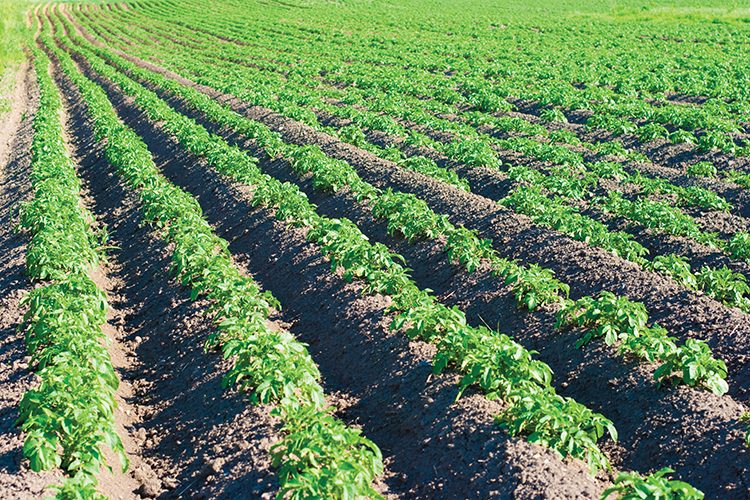
Home » Uncertainty abounds: What does 2020 hold for agriculture?
Uncertainty abounds: What does 2020 hold for agriculture?

June 15, 2020
While Lamb Weston and Mid-Columbia potato growers were dealing with an unexpected surplus of spuds this spring, Mid-Columbia asparagus farmers had a different tale to tell.
They had the skilled cutters they needed to bring in the harvest and prices were strong. 2020 was a solid year for the iconic first shoots of spring, thanks in some part to the coronavirus pandemic and the stay-home orders it inspired around the globe.
“Covid-19 is picking winners and losers. We are a winner right now,” said Alan Schreiber, director of the Washington Asparagus Commission.
As the first crop to ripen each spring, asparagus traditionally offers a hint at what the year will hold for Washington’s $10.6 billion agriculture industry. But the coronavirus pandemic has upended the narrative. Some crops, like asparagus, are thriving. Others face an uncertain future.
“It’s hit and miss,” said James Alford, a Franklin County farmer and president of the Franklin County Farm Bureau.
If asparagus is an apparent winner, potatoes are on the losing end, at least they were in May. Together, the two crops that are widely raised in the Mid-Columbia tell a story of an industry that is not certain what the pandemic holds for them.
It is an unsettling question for the state. Asparagus, potatoes and more than 300 other crops grow in Washington. Agriculture is 12 percent of Washington’s economy and its second-largest export category after airplanes, according to the state Department of Agriculture.
Mid-Columbia farmers produce a dizzying array of fruit, asparagus, hay, vegetables, dairy and other crops. Benton and Franklin counties produced a combined 17 percent of the state’s agricultural output, according to the 2017 Census of Agriculture, conducted every five years by the U.S. Department of Agriculture.
Dining in instead of out
Asparagus is a popular item to prepare and eat at home, helping drive its success in a shutdown.
Too, Washington-grown asparagus typically competes with asparagus grown in Mexico and Peru. The pandemic slowed shipping, giving Washington asparagus a clearer shot at the domestic market.
In contrast, potatoes should have had a banner year — and may still — but the season is off to a rocky start.
In January, Northwest frozen potato giant Lamb Weston posted rosy earnings and assured stock analysts it was prepared to manage potato shortages in North America and Europe during a quarterly earnings call.
That was before the full impact of the pandemic began to make itself known.
Potato processors urged growers to plant as much as possible, fearing border closures could affect supplies. But a week later, the industry did a 180-degree about face, Alford said.
The same processors called growers in late March to cancel about 15 percent of potato contracts. Overnight, thousands of planted acres had no buyer. And a potato without a buyer is of little value.
The potato shortage became a potato glut.
Surplus potatoes made their way to food banks and high-profile giveaways — 100,000 pounds at Kennewick’s Toyota Center, 200,000 pounds at the Tacoma Dome.
Without contracts, some farmers followed the lead of dairy farmers who dumped milk when school closures left them without enough customers: They plowed potatoes back into the field, walking away from the $2,000 an acre they spent on seed, fumigation and other early-season measures.
But Alford, who primarily grows potatoes on contract, said some are “going for broke,” pressing on without the safety net of a contract. They are betting on selling on the open market when the economy revives.
“There are a lot of guys who aren’t sleeping well at night,” he said.
Washington’s big crops
Washington leads the nation for apples ($3 billion) and hops ($476 million). It is the second-largest grower of potatoes, asparagus, onions and all kinds of grapes, all crops grown in the Mid-Columbia.
Asparagus always has served as a handy bellwether for those that follow. Asparagus cutters become cherry pickers and so forth.
Cherries, next on the ag calendar, were being watched on the hope labor and demand will swing their way in June. Alford said cherry growers are hopeful the same factors that drove at-home consumption for asparagus will transfer to cherries.
Coronavirus isn’t the sole worry. Trade wars led to retaliatory tariffs by India and China on Washington’s signature crop: Apples.
And wine grape growers were already struggling with a grape glut when the pandemic struck. It was always going to be a challenge to sell more wine. With restaurants and bars closed for an extended period, 2020 sales will be down.
And hop growers must contemplate the impact on their sole buyer — breweries. Beer consumption patterns are shifting in the pandemic toward mass-produced brews using less hops. Small and individual breweries face an existential crisis, according to a Brewing Association economist.
Benton and Franklin counties are Washington’s third and fourth largest ag-producing counties, after Yakima and Grant, according to a 2017 Census of Agriculture by the USDA.
Benton County had about 1,500 farms that collectively produced about $1 billion in sales, or 10 percent of the state’s total. It is tops for vegetables and potatoes, second for cattle and calves, and third for fruit, hay and livestock.
Franklin County had about 772 farms that produced $631.5 million in 2017, or 7 percent of the state total. It ranked third for vegetables and fourth for hay as well as milk from cows. Asparagus, tree fruit and potatoes are widely grown there as well.
Focus Magazine Agriculture + Viticulture
KEYWORDS june 2020




